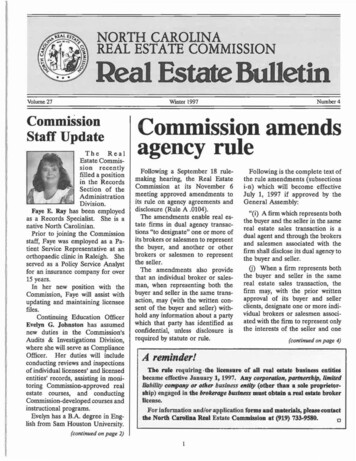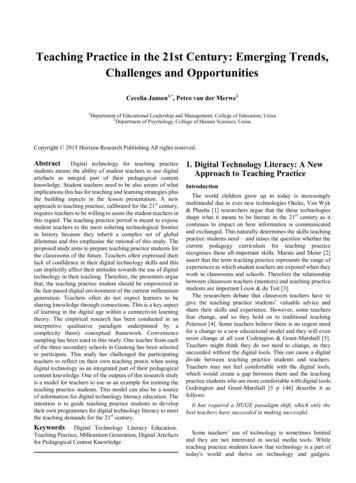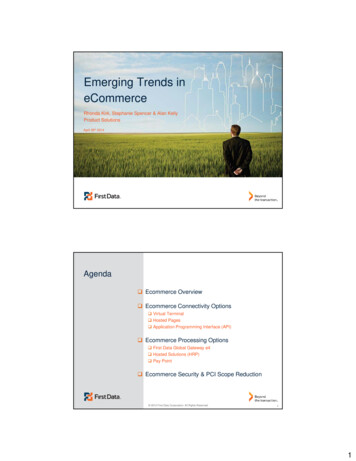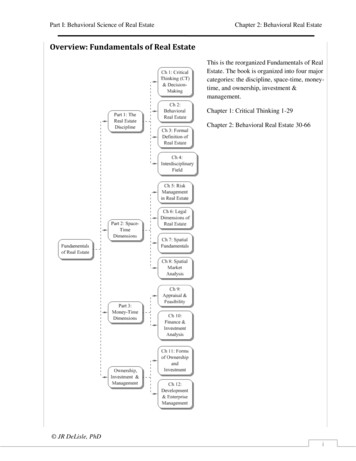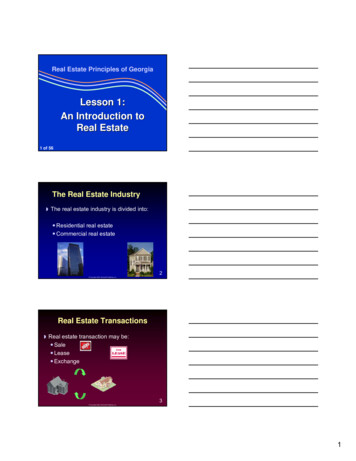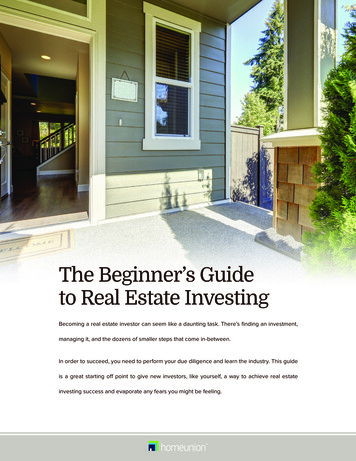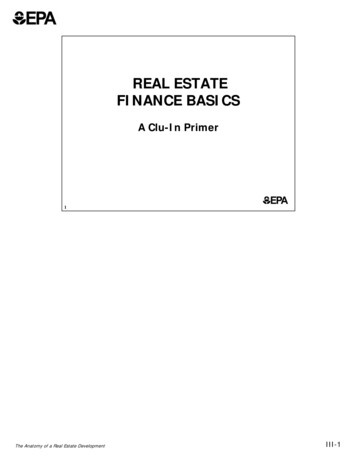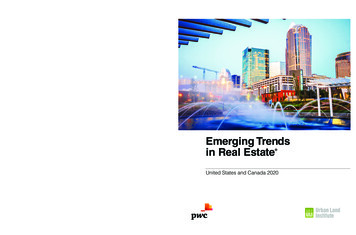
Transcription
Emerging Trends in Real Estate 2020HighlightsWhat are the best bets for investment and devel op ment in 2020? Based on insights from a selectgroup of the most influential and experienced ULImembers, this forecast will give you a heads-upon where to invest, which sectors and marketsoffer the best prospects, and trends in the capitalmarkets that will affect real estate. A joint under taking of PwC and ULI, this 41st edition of EmergingTrends is the forecast that you can count on forno-nonsense, expert insight. T ells you what to expect and what the expectedbest opportunities are. E laborates on trends in the capital markets,including sources and flows of equity anddebt capital. Indicates which property sectors offeropportunities and which ones to avoid. Provides rankings and assessments of avariety of specialty property types.ULI is the largest network of cross-disciplinaryreal estate and land use experts who lead thefuture of urban development and create thrivingcommunities around the globe. As a ULI member,you can connect with members around the world inthe Member Directory (members.uli.org), find ULIopportunities to lead and volunteer on Navigator(navigator.uli.org), and explore our latest researchand best practices on Knowledge Finder, includingall the Emerging Trends in Real Estate reportspublished since 2003. Visit uli.org/join to learn moreabout our exclusive member benefits. D escribes the impact of social and geopoliticaltrends on real estate. E xplains how locational preferences are changing. E lucidates the increasingly important intersectionof real estate and technology.Emerging Trendsin Real Estate U.S. 49.95United States and Canada 2020I S B N 978-0-87420-438-4549959780874 204384www.uli.orgwww.pwc.com
Emerging Trendsin Real Estate 2020Contents1Notice to Readers3 Chapter 1 Shifting Focus to the Decade Ahead4 Easing On Down the Road6 The Siren Call of TINA10 A New Menu for Markets11 Housing: The Great Unraveling13 A Community State of Mind14 Hipsturbia15 Boomers and Beyond: Let’s Think This Through17 ESG: A Sustainable Trend19 March of Technology: The What and Whenof Disruption21 Infrastructure: Washington Fumbles; States andCities Pick Up the Ball23 Chapter 2 Markets to Watch23 Top 20 Markets for 2020: A Tight Race towardthe Top31 Markets That Are Major Capital Magnets33 Stalwarts, Surprises, and Determined Competitors36 Markets Aligning with Expectations38 Treasures Ripe for Discovery?41 Potpourri: Thrifty Choices, Boutiques, andSpecial Situations48495362656973Chapter 3 Property Type OutlookIndustrialApartmentsSingle-Family HomesOfficeRetailHotels76 Chapter 4 Emerging Trends in CanadianReal Estate76 Putting Customers at the Heart of ReimaginedSpaces77 Powering Digital Transformation through Proptech79 Navigating Policy and Geopolitical Uncertainty81 Tackling Emerging Business Challenges83 Property Type Outlook87 Markets to Watch91 Expected Best Bets in 202096IntervieweesEmerging Trends in Real Estate 2020i
Editorial Leadership TeamEmerging Trends ChairsMitchell M. Roschelle, PwCW. Edward Walter, Urban Land InstituteAuthorsHugh F. KellyAnita KramerAndrew WarrenAuthors, Chapter 3: Property Type OutlookTimothy Corzine, RetailMelinda McLaughlin, IndustrialJohn McManus, Apartments and Single-Family HomesJanet Pogue McLaurin, OfficeMary Sullivan, HotelsContributorsKatharine BurgessJohn ChangElizabeth FosterBeth Burnham MaceMolly McCabeRyan SeverinoCarl WhitakerSenior AdvisersR. Byron Carlock Jr., PwCMiriam Gurza, PwC, CanadaFrank Magliocco, PwC, CanadaChristopher J. Potter, PwC, CanadaNick Way, PwCSteven Weisenburger, PwCULI Editorial and Production StaffJames A. Mulligan, Senior EditorDavid James Rose, Managing Editor/Manuscript EditorBrandon Weil, Creative Director/Cover DesignerDeanna Pineda, Muse Advertising Design, DesignerCraig Chapman, Senior Director, Publishing OperationsOwen Benge, Senior Associate, Capital Markets and Real EstatePayton Chung, Director, Capital Markets and Real EstateJacob Hite, Intern, Capital Markets and Real EstateEmerging Trends in Real Estate is a trademark of PwC and is registered in the United States and other countries. All rights reserved.At PwC, our purpose is to build trust in society and solve importantproblems. PwC is a network of firms in 158 countries with more than250,000 people who are committed to delivering quality in assurance,advisory, and tax services. Find out more and tell us what matters toyou by visiting us at www.pwc.com. 2019 PwC. All rights reserved. PwC refers to the U.S. member firmor one of its subsidiaries or affiliates, and may sometimes refer to thePwC network. Each member firm is a separate legal entity. Please seewww.pwc.com/structure for further details. August 2019 by PwC and the Urban Land Institute.Printed in the United States of America. All rights reserved. No partof this publication may be reproduced in any form or by any means,electronic or mechanical, including photocopying and recording, or byany information storage and retrieval system, without written permissionof the publisher.Recommended bibliographic listing:PwC and the Urban Land Institute: Emerging Trends in Real Estate 2020. Washington, D.C.: PwC and the Urban Land Institute, 2019.ISBN: 978-0-87420-438-4iiEmerging Trends in Real Estate 2020PwC Advisers and Contributing ResearchersAbhi JainAki DellaportasAlex Howieson*Ali Abbas*Alpa Patel*Ami Patel*Amy Brohman*Amy MatulaAndrew AlpersteinAndrew Nickel*Andrew Popert*Anthony Di Nuzzo*Ashley Somchanh*Ashley Yanke*Avery MungerAynsley Price*Brett MatzekBrian NessBryan Allsopp*Bud ThomasCalen ByersCarly Stallwood*Carmelo Scali*Cathy HelmbrechtCharlene Rodenhiser*Charles CampanyChris DietrickChris Vangou*Christian SedorChristina Howton*Christina LouieChristine Lam*Christopher BaileyChristopher MillCourt MatonCourtney McNeilCurtis Gagne*Dan RyanDana MiccioDaniel D’Archivio*Danielle Desjardins*Darren Speake*David BaldwinDavid BaranickDavid SeamanDavid SwerlingDavid VossDavid Whiteley*Dheeraj Bisla*Dillon WhiteDouglas StruckmanDylan AndersonDylan ShuffEd FaccioElliot KungEmily PillarsErin MacDonaldErnie Hudson*Eugene M. ChanEvan CohenFrancis Miu*François Berthiaume*Fred Cassano*Frédéric Lepage*Gary MeltzerGimena de Buen*Gina Mandarino*Glenn Kauth*Harry de Haas*Heather LashwayHelen Zarokostas*Howard Quon*Howard RoIan Gunn*Ian NelsonIra ShawIsabelle MorganJacqueline KellyJacqueline KinnearyJasen Kwong*Jason HirschfeldJason Ho*Jason Pagliaro*Jeremy LewisJesse RosenstockJoannie Brulotte*John Bunting*John CrossmanJohn RosanoJohn SatelmajerJohnny Cannon*Jonathan Osten*Joon Chan*Jordan Bennett*Joseph H. SchechterJoseph Moyer*Joshua Beaver*Karin CoetzeeKatelyn WeissKelsey McLeod*Ken Griffin*Ken Su*Keri ZaderKevin FosseeKevin KoonsKevin Ng*Kristen ConnerKristina Derek*Lanie PotgieterLaura Eldridge*Leah Gates*Leah WaldrumLee OverstreetLibarid Guluzian*Lori Watson*Lori-Ann Beausoleil*Macy AndersonMais Jarjour-OuzonMatt ManzaMatthew RosenbergMatthew ManzaMaxime Lessard*Megan AndrewsMiranda Hardy*Mori ContrerasMunezeh WaldNadia King*Nadja Ibrahim*Natalie Cheng*Nick Ethier*Nicole StroudPatricia Perruzza*Paul MehlmanPeter Harris*Philippe Pourreaux*Qiyan MaiRachel KleinRahim Lallani*Rajen Shah*Rajveer Hundal*Ray WitkosRebecca Lyons*Renee SarriaRicardo RuizRichard FournierRick Barnay*Rick MunnRob SciaudoneRon Bidulka*Ron Walsh*Rosanna Musto*Roxanne Carrier*Ryan DumaisSabrina Fitzgerald*Sam MelehaniSantino Gurreri*Scott WilliamsonSean Bailey*Sergio LozanoSpyros Stathonikos*Stephen CrisafulliSteve BakerSteve TylerSteven TiradoTanya Hill-Larivière*Tara JangleThomas KnoxThomas KozakTim BodnerTom KnoxTom WilkinTressa Teranishi*Trevor Toombs*Warren MarrWendi Pope*Yousuf AbbasiZac Konings*Zoe Funk*Canada-based.
Notice to ReadersEmerging Trends in Real Estate is a trends and forecast publication now in its 41stedition, and is one of the most highly regarded and widely read forecast reports in thereal estate industry. Emerging Trends in Real Estate 2020, undertaken jointly by PwCand the Urban Land Institute, provides an outlook on real estate investment and development trends, real estate finance and capital markets, property sectors, metropolitanareas, and other real estate issues throughout the United States and Canada.Emerging Trends in Real Estate 2020 reflects the views of individuals who completedsurveys or were interviewed as a part of the research process for this report. Theviews expressed herein, including all comments appearing in quotes, are obtainedexclusively from these surveys and interviews and do not express the opinions of eitherPwC or ULI. Interviewees and survey participants represent a wide range of industry experts, including investors, fund managers, developers, property companies,lenders, brokers, advisers, and consultants. ULI and PwC researchers personally interviewed 750 individuals, and survey responses were received from more than 1,500individuals, whose company affiliations are broken down below:Private property owner or commercial real estate developer:27.6%Real estate advisory or service firm:23.6%Homebuilder or residential land developer:11.9%Private equity real estate investor:11.3%Bank lender:6.5%Investment manager/adviser:6.5%Equity REIT or publicly listed real estate property company:3.9%Institutional equity investor:1.8%Private REIT or nontraded real estate property company:1.7%Institutional lender:1.0%Mortgage REIT:0.9%Real estate debt investor:0.8%Securitized lender:0.7%Other entity:1.8%Throughout this publication, the views of interviewees and/or survey respondentshave been presented as direct quotations from the participant without name-specificattribution to any particular participant. A list of the interview participants in this year’sstudy who chose to be identified appears at the end of this report, but it should benoted that all interviewees are given the option to remain anonymous regarding theirparticipation. In several cases, quotes contained herein were obtained from interviewees who are not listed in the back of this report. Readers are cautioned not to attemptto attribute any quote to a specific individual or company.To all who helped, the Institute and PwC extend sincere thanks for sharing valuabletime and expertise. Without the involvement of these many individuals, this reportwould not have been possible.Emerging Trends in Real Estate 20201
2Emerging Trends in Real Estate 2020
Chapter 1: Shifting Focus to the Decade AheadShifting Focus to the Decade Ahead“‘We’ve always done it this way’ doesn’t cut it in real estate anymore. We needthe best way to do it.”“The last 18 months roughly has been one of the more staticperiods I’ve seen in my career. I don’t mean static in a badsense. I only mean the sense that whatever I would have said18 months ago is not much different than I would have said thisweek,” says a veteran real estate pro whose real estate careerextends back to the Ronald Reagan years. In fact, many of ourinterviewees and focus groups noted the “on track” character ofrecent activity in the property development and investment field.This does not mean that they are in “Groundhog Day” mode. Noone claims we are in a time warp. Most of the experts in the realestate business are following through on business plans thathave served them well over the past year and look like a solidroadmap for the future.Exhibit 1-1 U.S. Real Estate Returns and Economic GrowthIndex change50%GDPNAREIT Equity REIT Index6%40%4%30%3%20%2%10%1%0%-10%-20%1998 2000 2002 2004 2006 2008 2010 2012 2014 2016 2018 2020*NCREIFTrends—by their nature—are dynamic. Time is a stream, not afrozen pond. That stream runs toward the future, and each yearputs some conditions into the past, and brings some conditionscloser to realization. If the pace is gradual, we may hardly feelthe changes. But they are happening even if subtly.That is one reason that an annual examination of EmergingTrends is such a healthy and helpful exercise. It is when changeExhibit 1-2 Firm Profitability Prospects for 2020100%5%0%FairGDP change60%That is exactly what “trends” should produce—confidence thata business should not try to start from scratch every year. If youhave thoughtfully assessed your resources, been careful aboutyour objectives, and lined up the physical, financial, and humanassets needed for success—well, your approach should havesome staying power.-1%-2%-30%-3%-40%-4%Sources: NCREIF, NAREIT, Bureau of Economic Analysis/U.S. Department of Commerce,PwC Investor Survey.*Data for 2019 and 2020 are forecasts from the PwC Investor Survey, completed in 2Q 2019.Percentage of respondentsto 11 2012 2013 2014 2015 2016 2017 2018 2019 2020Source: Emerging Trends in Real Estate surveys.Emerging Trends in Real Estate 20203
is so subtle that it may escape notice that that we need to payeven more careful attention.Trends, by the way, are just one form of change. Our discussionof trends keeps in mind that the world, the economy, and thereal estate business are subject to other kinds of influence in theriver of time.Cycles are perhaps the most prominent feature of the real estateindustry, and we discuss late-cycle behaviors in this chapter.Trends typically persist longer than cycles. We examine thepotential impact of the decades-long deceleration of the U.S.economy on real estate as we emerge from the next recession:slower demand over the decade of the 2020s.Maturation is another form of change, generational aging as wellas the aging of our infrastructure. Will future cohorts continuepatterns of previous generations? Boomers have frustrated predictions since they burst upon the scene, and advances in lifesciences may permit them to do so again in their 70s and 80s.Our infrastructure, meanwhile, could use rejuvenation and maybe seeing an infusion of capital at the state and local levels evenas entropy rules in Washington.Technology continues to present disruption—another form ofchange—as both a risk and an opportunity. We should not ruleout the capacity of capital markets to be a disrupter either. Theabundance of capital for debt and equity is a feature of marketsfor now. But capital markets are notoriously fickle and real estateveterans are well aware of how quickly a “Niagara of capital”can be dammed up.Physicists recognize “change of state” as another time-basedphenomenon affecting real estate. The shift from a blue-collareconomy to a white-collar economy profoundly adjusted property needs, as did the dramatic increase in female labor forceparticipation. Today, we are experiencing changes of state in thehousing market, which may see homeownership in the 2020sdrop to levels not seen since the 1930s and 1940s. We arealready seeing such qualitative shifts as the rise of “hipsturbias”in our metro areas. A change in ethos also is observable. Theenvironmental, social, and governance (ESG) movement hastaken root in the corporate and institutional investment world.Real estate operations, meanwhile, are more and more attunedto a preference for “community” in the places where we live,work, and play.Our level of awareness concerning the complex nature ofchange is increasing, but probably not to the degree that it4Emerging Trends in Real Estate 2020Exhibit 1-3 Emerging Trends Barometer 8201020122014201620182020Source: Emerging Trends in Real Estate surveys.Note: Based on U.S. respondents only.should be. But, as Holmes often noted to Watson, “The gameis afoot.”1. Easing On Down the RoadQueried about cyclical risk and opportunity, one REIT executivequipped, “Don’t ask me what inning we are in. We are playingcricket!” As this economic cycle entered the history books asthe longest in U.S. history, the level of confidence in the realestate industry has been palpable.Property veterans see the internal conditions in the business assolid. “Real estate will continue to perform,” one experiencedinvestment manager said. “We don’t see oversupply or overleverage.” Developers continue to see opportunities, and oneSun Belt broker commented, “Builders going gangbusters eventhough the cycle is old makes me feel good.” A New York–based construction executive chimed in, “It is encouraging tonote that the biggest, most sophisticated developers are stillactive.”Reinforcing the optimism about real estate’s ability to withstanda recession is satisfaction that the property sector’s disciplinein this recovery means that “this time it won’t be our fault” if theeconomy falters. Any warning signs are arising from causesthat real estate has little control over. As an economist from aninstitutional investor put it, “How much energy should you useworrying about stuff you have no ability to change?”This economy may not be as robust as many believe. Althoughthe consensus of economists has real gross domestic product
Chapter 1: Shifting Focus to the Decade AheadExhibit 1-4 Debt Underwriting Standards Forecastfor the United StatesExhibit 1-6 Availability of Capital for Real Estate,2020 versus 2019Less rigorous Remain the same More rigorous2020 13.1%52.4%Lending source34.5%2019 24.945.030.12018 16.847.036.22017 8.444.247.42016 35.451.712.92015 45.744.79.62014 43.339.417.3Debt funds3.513.5220202019Nonbank financial 3.49institutions 3.573.21Insurance companies 3.293.12Mortgage REITs 2.973.08Securitized lenders/CMBS 3.19Source: Emerging Trends in Real Estate surveys.Note: Based on U.S. respondents only.3.01Commercial banks 3.31Exhibit 1-5 Equity Underwriting Standards Forecastfor the United StatesGovernment-sponsored 2.91enterprises 3.24Less rigorous Remain the same More rigorousEquity source2020 12.9%55.5%31.6%2019 21.148.730.22018 17.151.431.52017 11.554.234.32016 3452.413.62015 41.447.511.12014 30.750.818.5Source: Emerging Trends in Real Estate surveys.Note: Based on U.S. respondents only.Private equity/opportunity/ 3.44hedge funds 3.4120202019Institutional investors/ 3.32pension funds 3.473.27Private local investors 3.383.17Private REITs 2.923.09Foreign investors 3.323.00(GDP) closing out 2019 with a 2.5 percent gain, and a slowingbut still-positive 1.8 percent advance in 2020, the “stuff you haveno ability to change” is still out there—and worthy of heed. Theyield-curve inversion that took hold and then deepened duringthe first half of 2019 leads the list of warning signals. Housingstarts have been softening, and the 6.6 percent year-over-yeardecline in residential permits recorded in June is presaging aweakening period ahead. Auto sales also have been languid,with implications for the consumer economy as well as for themanufacturing sector heading into 2020. Viewed one way, thedecision of the Fed to ease interest rates at its July FederalOpen Market Committee meeting is a sign of concern over theconfluence of these domestic signals as well as a hedge againstinternational risks in both finance and trade.Another significant indicator of the economy’s fragility, whichthe short memories of the 24-hour news cycle seem to haveforgotten, is the impact that the government shutdown of lastPublic-equity REITs 3.201 2Largedecline3Staythe same45LargeincreaseSource: Emerging Trends in Real Estate surveys.Note: Based on U.S. respondents only.winter had on hundreds of thousands of workers with “secure”jobs. The delay in receiving a couple of paychecks prompteda run on food banks and sent households scrambling to meetrent and home mortgage payments. This amounted to a “naturalexperiment” validating estimates that 41 percent of U.S. households struggle with an emergency expense as little as 400,since they must first meet their existing obligations. The extentto which so many households are “on the edge” is likely underestimated in macroeconomic models.Recessions strike the economy at its points of excess. Manybelieve that the shape of the present expansion—moderate inpace as well as extended in length—has protected it from overEmerging Trends in Real Estate 20205
But
Emerging Trends in Real Estate 2020 1 Notice to Readers Emerging Trends in Real Estate is a trends and forecast publication now in its 41st edition, and is one of the mos

